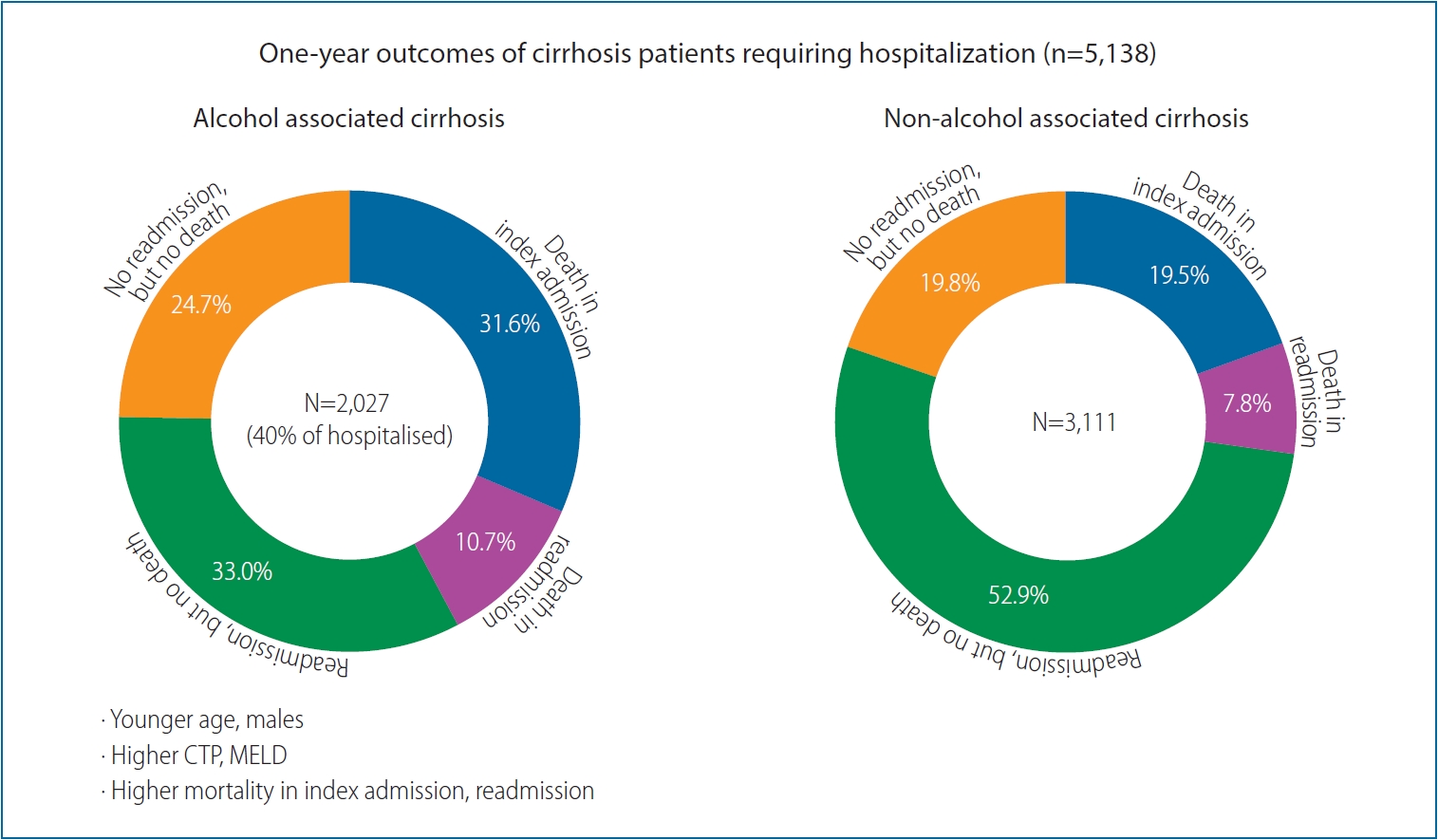| Clin Mol Hepatol > Volume 27(1); 2021 > Article |
|
ABSTRACT
Background/Aims
Methods
Results
FOOTNOTES
Figure┬Ā1.

Figure┬Ā2.

Figure┬Ā3.

Table┬Ā1.
Table┬Ā2.
| Variable | Incidence risk ratio* | 95% CI | P-value |
|---|---|---|---|
| Year of admission | |||
| ŌĆā2010 | Ref. | ||
| ŌĆā2011 | 1.59 | 1.23ŌĆō2.06 | <0.001 |
| ŌĆā2012 | 2.30 | 1.81ŌĆō2.91 | <0.001 |
| ŌĆā2013 | 1.95 | 1.54ŌĆō2.46 | <0.001 |
| ŌĆā2014 | 2.30 | 1.82ŌĆō2.90 | <0.001 |
| ŌĆā2015 | 2.11 | 1.66ŌĆō2.67 | <0.001 |
| ŌĆā2016 | 2.96 | 2.33ŌĆō3.76 | <0.001 |
| ŌĆā2017 | 2.58 | 2.02ŌĆō3.28 | <0.001 |
| Age bracket (years) | |||
| ŌĆā<40 | Ref. | ||
| ŌĆā41ŌĆō50 | 1.15 | 1.00ŌĆō1.33 | 0.06 |
| ŌĆā51ŌĆō60 | 1.11 | 0.96ŌĆō1.27 | 0.15 |
| ŌĆā>60 | 1.21 | 1.10ŌĆō1.34 | 0.03 |
| Gender | |||
| ŌĆāFemale | Ref. | ||
| ŌĆāMale | 1.36 | 1.20ŌĆō1.54 | <0.001 |
| Etiology | |||
| ŌĆāAlcoholic | 1.88 | 1.71ŌĆō2.07 | <0.001 |
| ŌĆāHBV | 0.76 | 0.66ŌĆō0.89 | <0.001 |
| ŌĆāHCV | 0.61 | 0.52ŌĆō0.72 | <0.001 |
| ŌĆāNASH | 0.72 | 0.63ŌĆō0.82 | <0.001 |
| ŌĆāAutoimmune | 0.61 | 0.49ŌĆō0.75 | <0.001 |
| ŌĆāCryptogenic | 0.81 | 0.71ŌĆō0.93 | 0.004 |
| Complication | |||
| ŌĆāAscites | 2.40 | 2.11ŌĆō2.73 | <0.001 |
| ŌĆāSepsis | 4.50 | 4.07ŌĆō4.97 | <0.001 |
| ŌĆāHCC | 0.87 | 0.74ŌĆō1.02 | <0.001 |
| ŌĆāHRS | 2.58 | 2.27ŌĆō2.94 | <0.001 |
| ŌĆāSBP | 1.92 | 1.72ŌĆō2.14 | <0.001 |
| ŌĆāAVB | 1.30 | 1.17ŌĆō1.44 | <0.001 |
| ŌĆāHE | 3.81 | 3.45ŌĆō4.19 | <0.001 |
| Severity score | |||
| ŌĆāCTP >10.5 | 6.34 | 5.60ŌĆō7.10 | <0.001 |
| ŌĆāMELD >19.0 | 6.30 | 5.50ŌĆō7.20 | <0.001 |
CI, confidence interval; Ref., reference; HBV, hepatitis B virus; HCV, hepatitis C virus; NASH, nonalcoholic steatohepatitis; HCC, hepatocellular carcinoma; HRS, hepatorenal syndrome; SBP, spontaneous bacterial peritonitis; AVB, acute variceal bleed; HE, hepatic encephalopathy; CTP, Child-Pugh; MELD, model for end-stage liver disease.
Table┬Ā3.
Values are presented as mean┬▒standard deviation or number (%).
ALD, alcoholic liver disease; HBV, hepatitis B virus; HCV, hepatitis C virus; NASH, nonalcoholic steatohepatitis; HCC, hepatocellular carcinoma; HRS, hepatorenal syndrome; SBP, spontaneous bacterial peritonitis; AVB, acute variceal bleeding; HE, hepatic encephalopathy; CTP, Child-Pugh; MELD, model for end-stage liver disease.
Abbreviations
REFERENCES
- TOOLS
-
METRICS

- ORCID iDs
-
Shiv Kumar Sarin

https://orcid.org/0000-0002-0544-5610 - Related articles




 PDF Links
PDF Links PubReader
PubReader ePub Link
ePub Link Full text via DOI
Full text via DOI Full text via PMC
Full text via PMC Download Citation
Download Citation Print
Print



